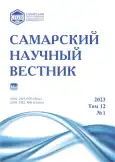Роль зелёных насаждений в повышении качества здоровья городского населения (на примере г. Нижнего Новгорода)
- Авторы: Большакова А.Д.1, Зазнобина Н.И.1, Ковалева Т.А.1
-
Учреждения:
- Национальный исследовательский Нижегородский государственный университет им. Н.И. Лобачевского
- Выпуск: Том 12, № 1 (2023)
- Страницы: 27-33
- Раздел: Биологические науки
- URL: https://journals.rcsi.science/2309-4370/article/view/133939
- DOI: https://doi.org/10.55355/snv2023121104
- ID: 133939
Цитировать
Полный текст
Аннотация
Загрязнение атмосферного воздуха является одной из самых серьезных экологических угроз для здоровья человека. Реализация мероприятий по снижению уровня загрязнения воздуха сокращают риск развития заболеваний. В число подобных мероприятий входит создание комфортной среды за счет озеленения городских территорий. Зелёные насаждения в городах выполняют важную средообразующую функцию – очищение воздуха от поллютантов. Цель исследования: оценка степени снижения неканцерогенного риска развития заболеваний у населения крупного города (на примере г. Н. Новгорода) по уровню очищения атмосферного воздуха от поллютантов зелёными насаждениями. На основе рассчитанных концентраций приоритетных загрязняющих веществ (монооксида углерода, диоксида азота, диоксида серы, озона и взвешенных частиц (PM₂ˏ₅ и PM₁₀)) и данных по инвентаризации зелёных насаждений на восьми крупнейших площадях г. Н. Новгорода, оценено повышение качества атмосферного воздуха до 42,12%. На основе созданных карт реального озеленения исследуемых площадей в программе QGIS Desktop были разработаны проекты по расширению озеленения их территорий. Проведена оценка качества воздуха на обследованных площадях г. Н. Новгорода и рассчитан неканцерогенный риск развития заболеваний сердечно-сосудистой системы и верхних дыхательных путей у жителей г. Н. Новгорода при отсутствии растительности, при реальном озеленении и в соответствии с предложенными проектами перспективного озеленения. При реализации предложенных проектов перспективного озеленения риск развития заболеваемости органов дыхания и сердечно-сосудистой системы у населения г. Н. Новгорода может снизиться на 25% в среднем по городу.
Полный текст
Открыть статью на сайте журналаОб авторах
Анжела Дмитриевна Большакова
Национальный исследовательский Нижегородский государственный университет им. Н.И. Лобачевского
Автор, ответственный за переписку.
Email: anzhela.bolschakova@yandex.ru
аспирант кафедры экологии
Россия, Нижний НовгородНаталья Ивановна Зазнобина
Национальный исследовательский Нижегородский государственный университет им. Н.И. Лобачевского
Email: nzaznobina@mail.ru
кандидат биологических наук, доцент кафедры экологии
Россия, Нижний НовгородТаисия Александровна Ковалева
Национальный исследовательский Нижегородский государственный университет им. Н.И. Лобачевского
Email: kovalevataisia79@gmail.com
магистрант кафедры экологии
Россия, Нижний НовгородСписок литературы
- WHO global air quality guidelines: particulate matter (PM₂ˏ₅ and PM₁₀), ozone, nitrogen dioxide, sulfur dioxide and carbon monoxide // Report World Health Organization, 2021. 290 p.
- Derkzen M.L., van Teeffelen A.J.A., Verburg P.H. Quantifying urban ecosystem services based on high-resolution data of urban green space: an assessment for Rotterdam, the Netherlands // Journal of Applied Ecology. 2015. Vol. 52, iss. 4. P. 1020–1032. doi: 10.1111/1365-2664.12469.
- Годовой отчет о ходе реализации пилотной государственной программы Российской Федерации «Развитие транспортной системы» и об оценке ее эффективности в 2021 году [Электронный ресурс] // Министерство транспорта Российской Федерации. https://mintrans.gov.ru/documents/11/11833.
- Camps-Calvet M., Langemeyer J., Calvet-Mir L., Gomez-Baggethun E. Ecosystem services provided by urban gardens in Barcelona, Spain: insights for policy and planning // Environmental Science & Policy. 2016. Vol. 62. P. 14–23. doi: 10.1016/j.envsci.2016.01.007.
- Baines O., Wilkes P., Disney M. Quantifying urban forest structure with open-access remote sensing data sets // Urban Forestry & Urban Greening. 2020. Vol. 50. doi: 10.1016/j.ufug.2020.126653.
- Guerry A.D., Smith J.R., Lonsdorf E., Daily G.C., Wang X., Chun Y. Urban nature and biodiversity for cities. Washington: World Bank, 2021. 48 p.
- Экосистемные услуги России: прототип национального доклада. Т. 1. Услуги наземных экосистем / ред.-сост. Е.Н. Букварёва, Д.Г. Замолодчиков. М.: Изд-во Центра охраны дикой природы, 2016. 148 с.
- Экосистемные услуги России: прототип национального доклада. Т. 2. Биоразнообразие и экосистемные услуги: принципы учета в России / сост. Е.Н. Букварёва, Т.В. Свиридова. М.: Изд-во Центра охраны дикой природы. 2020. 252 с.
- Экосистемные услуги России: прототип национального доклада. Т. 3. Зелёная инфраструктура и экосистемные услуги крупнейших городов России / ред. О.А. Климанова. М.: Изд-во Центра охраны дикой природы. 2021. 112 с.
- Akaraci S., Feng X., Suesse T., Jalaludin B., Astell-Burt T. Associations between green space, air pollution and birthweight in Sydney Metropolitan Area, Australia // Urban Forestry & Urban Greening. 2022. Vol. 76. doi: 10.1016/j.ufug.2022.127726.
- Gelashvili D.B., Solovyeva I.V., Belova I.V., Tochilina A.G., Yakimov B.N., Zaznobina N.I., Molkova E.D., Filashikhin N.A. Ecological structure of the public transportation microbiocoenosis // Biology Bulletin. 2020. Vol. 47, № 10. P. 1301–1308. doi: 10.1134/s1062359020100052.
- Территориальный орган Федеральной службы государственной статистики по Нижегородской области [Электронный ресурс] // https://52.rosstat.gov.ru.
- Автопром в России. Итоги 2022 года, перспективы [Электронный ресурс] // Аналитическое агентство «Автостат». https://www.autostat.ru/research/product/491.
- ГОСТ Р 56162-2019. Выбросы загрязняющих веществ в атмосферу. Метод расчета количества выбросов загрязняющих веществ в атмосферу потоками автотранспортных средств на автомобильных дорогах разной категории. М.: Стандартинформ, 2019. 16 с.
- Шаров А.Ю., Шомин И.И. Экологическая безопасность на автомобильном транспорте: метод. указания. Екатеринбург: УГЛТУ, 2007. 25 с.
- Обзор состояния и загрязнения окружающей среды в Российской Федерации за 2021 год. М.: Росгидромет, 2022. 220 с.
- Nowak D.J. Understanding i-Tree: summary of programs and methods. Madison, 2020. 105 p.
- Hirabayashi S., Kroll C.N., Nowak D.J., Endreny T.A. i-Tree eco dry deposition model descriptions. Washington, 2015. 46 p.
- Онищенко Г.Г. Оценка и управление рисками для здоровья как эффективный инструмент решения задач обеспечения санитарно-эпидемиологического благополучия населения Российской Федерации // Анализ риска здоровью. 2013. № 1. С. 4–14.
- Р 2.1.10.1920-04. Руководство по оценке риска для здоровья населения при воздействии химических веществ, загрязняющих окружающую среду. М.: Федеральный центр госсанэпиднадзора Минздрава России, 2004. 143 с.
Дополнительные файлы










